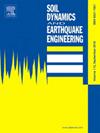Effect of soil-structure interaction on seismic behavior of self-centering rocking piers supported on shallow foundations
IF 4.2
2区 工程技术
Q1 ENGINEERING, GEOLOGICAL
引用次数: 0
Abstract
The soil structure interaction (SSI) can severely affect the behavior of a structural system. This paper examines the impact of the SSI on the seismic performance of self-centering (SC) rocking piers. Finite element (FE) models of conventional reinforced concrete (RC) piers and SC rocking piers with and without energy dissipators are built and validated. The soil-foundation-structure interaction is modeled using the beam-on-nonlinear-Winkler-foundation (BNWF) approach, capturing the nonlinear behavior of soil. This approach is also validated, comparing the settlement and moment-rotation behavior of the numerical simulation and experimental results. Various scenarios, including different foundations and soil types, are considered. Nonlinear cyclic and dynamic analyses are performed. Three sets of fragility curves are obtained, assuming maximum drift, residual drift, and foundation settlement as engineering demand parameters (EDPs). The effect of earthquake frequency content and duration are also investigated. The results show that SC rocking piers can reduce settlements, but a relatively strong foundation is needed to carry out the expected seismic performance level and effectively reduce residual drifts.
土-结构相互作用对浅基础自定心摇动墩抗震行为的影响
本文章由计算机程序翻译,如有差异,请以英文原文为准。
求助全文
约1分钟内获得全文
求助全文
来源期刊

Soil Dynamics and Earthquake Engineering
工程技术-地球科学综合
CiteScore
7.50
自引率
15.00%
发文量
446
审稿时长
8 months
期刊介绍:
The journal aims to encourage and enhance the role of mechanics and other disciplines as they relate to earthquake engineering by providing opportunities for the publication of the work of applied mathematicians, engineers and other applied scientists involved in solving problems closely related to the field of earthquake engineering and geotechnical earthquake engineering.
Emphasis is placed on new concepts and techniques, but case histories will also be published if they enhance the presentation and understanding of new technical concepts.
 求助内容:
求助内容: 应助结果提醒方式:
应助结果提醒方式:


